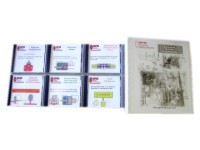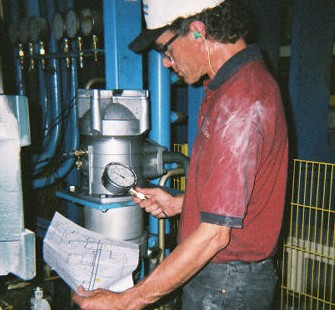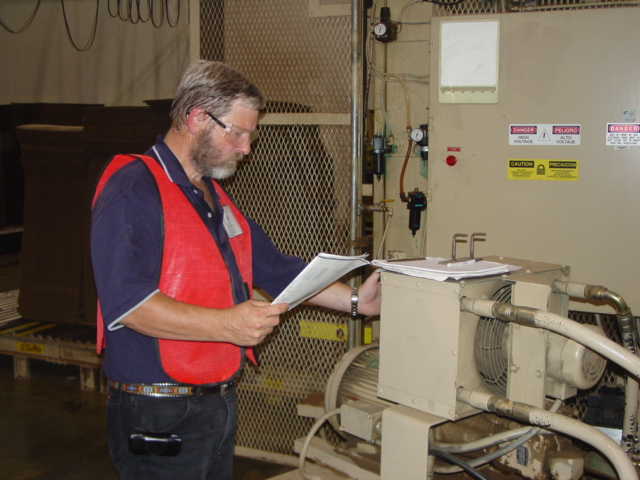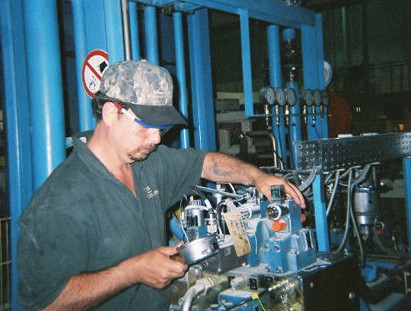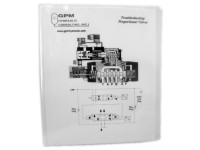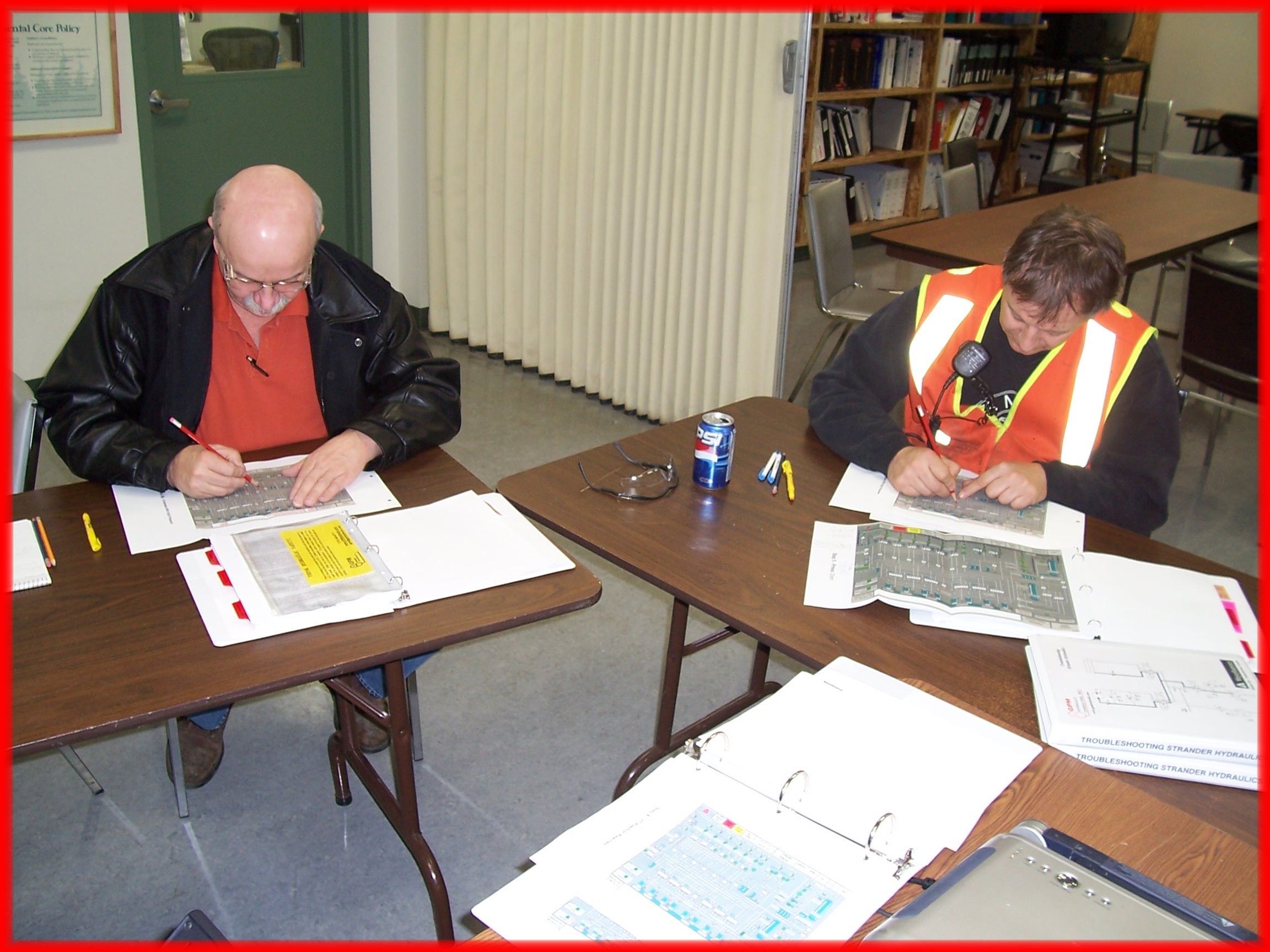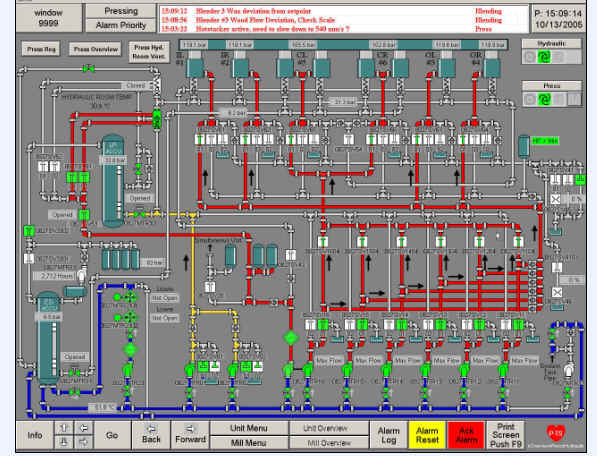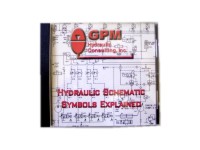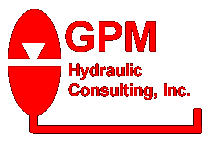
P.O. Box 689 Social Circle, GA 30025 (678) 267-3395 gpm@gpmhydraulic.com
|
August 2006 | ||||||||||||
|
CLICK HERE to send this newsletter to a friend! |
|||||||||||||
|
|||||||||||||
|
|
|||||||||||||
|
|
Maintenance Hydraulic Troubleshooting on Interactive CD Our nationally acclaimed
Maintenance Hydraulic Troubleshooting workshop
on six fully interactive CD's. Includes our MHT workshop manual.
6-CD Set - $1200 Individual CD's - $250
+ Shipping and Handling.
Click on http://gpmhydraulic.com/mhtcds.htm
to find out more.
|
||||||||||||
| 1. Should I flush my hydraulic system or change the oil? | |||||||||||||
 Jack Weeks -
Consultant for GPM Hydraulic Consulting Inc.
Jack Weeks -
Consultant for GPM Hydraulic Consulting Inc. |
|||||||||||||
|
Over 96% of hydraulic failures are directly related to
the condition of the hydraulic oil. When you think about it, in theory
a hydraulic system should never wear out. After all, no two surfaces
ever actually touch - there is always a buffer of hydraulic oil between any
two metal surfaces. In practice however, components DO wear out.
Why? Obviously, that is because most hydraulic systems have particles
of contamination that are forced through the tight tolerances of the
components taking material away with them as they pass through.
So the answer to machine longevity must be to change the oil regularly, right? Well, maybe. What is the procedure for changing oil? Do we just drain and discard the old oil and put new oil in? Not if we want the machine to last very long. New oil is not clean enough for a hydraulic system. It probably is when it is first refined. But it must be transported and packaged. By the time it reaches a facility, we are doing very well if the oil meets a 50 - 200 micron standard. It is absolutely essential that new oil be filtered prior to entering the system. Most hydraulic machines require that the oil be filtered to 10 microns or less to avoid component damage. How often should oil be changed? I am asked that question all the time. I wish I had a good answer for that one - such as changing oil in a car every 3000 miles. But the fact is that there are so many variables involved that the only way to know for sure is to monitor the condition of the oil. Samples of hydraulic oil should be taken at least quarterly and analyzed in a laboratory. The results of that analysis will tell you if the oil requires attention. What about the cost of the oil? There is no question that hydraulic oil is very expensive. The cost varies by location, but I was told recently that one plant was paying $600 for a 55-gallon drum. That's almost $11 a gallon! For a large reservoir, this could be a significant cost. Is flushing the system good enough? Depending on the procedure you use, it could not only be enough but could be even BETTER than changing the oil. Assuming the oil has not been burned or simply worn out (lost viscosity) it can be reclaimed. This can be contracted out for less than the cost of new oil (GPM Hydraulic Consulting can do it for you or there are several other companies) or you can purchase a flushing machine and do it yourself. When oil is only changed, even if you clean out the reservoir, a significant amount of oil is left in the machine. Oil in the actuators, valves and hydraulic lines is still there contaminating the system. Within a few days, a sample taken from the machine may not be much better than one taken before changing the oil. This is because the new oil will remove deposits that have accumulated since the last oil change and bring them back to the reservoir. A flushing machine can remove all of these deposits while the system runs with no interruption of service. The flushing machine is little more than a "kidney loop" recirculating system with a very large filter. The type we use is rated at 1 micron with a beta rating of over 200. The beta rating is a ratio between the number of particles of a specific size (1 micron in this case) that enter the filter vs. the number that exit the filter. Steps for flushing the system are as follows:
What about system cleaning solvents - will they do as good a job without having to purchase a flushing machine or contract someone to flush the system? They will. I have used some of these products with excellent results. And on a system that is badly trashed with varnish deposits and such, it may be the only way to go. It is expensive however, particularly on systems with large reservoirs, and they do require an interruption of service. The dirty oil must first be drained and discarded. The system is then filled with flushing oil and a 5 - 10% solution of the solvent as directed by the manufacturer. I do not recommend putting the machine in service while using the system cleaner, though some products claim it can be done if the oil viscosity is not significantly changed by the solvent. Valves and actuators should be removed and cleaned manually with carburetor cleaner or some other solvent that can remove varnish. Flushing blocks are installed wherever components are removed and the system should run for at least 12 hours. When flushing is complete, drain the flushing oil and measure the amount that comes out before discarding. If at least 90% of the oil cannot be removed, fill the system again with oil, run for one hour, discard the oil and replace with new oil that has been filtered to the specifications of the machine. Obviously, this requires a lot of oil and downtime but there may be no other choice on machines that have badly overheated. |
|||||||||||||
| Jack Weeks entered GPM’s organization in January of 1997 as a CAD draftsman and hydraulic instructor. He has trained thousands of electricians and mechanics in Hydraulic Troubleshooting methods. His computerized animations have made GPM's presentations and training CD's the recognized leader in the industry. He received his education from the Georgia Institute of Technology School of Electrical Engineering and the Department of State Foreign Service Institute. Jack is an experienced draftsman and taught telecommunications equipment operation and repair for the Central Intelligence Agency at American embassies overseas. | |||||||||||||
| 2. The GPM Grapevine | |||||||||||||
 Robin Garner
- GPM Training Coordinator
Robin Garner
- GPM Training Coordinator
|
|||||||||||||
|
As the outside temperature went up
to the high 90’s here in Georgia, our customers’ hydraulic oil temp
rose accordingly. It was a
month full of corrugated for Al as he worked with plants in Memphis, TN
and Covington, GA in diagnosing and troubleshooting heat and pressure
problems on their systems. He
also completed the technical writing on a 362 page “Troubleshooting OSB
Hydraulics” manual for a mill in South Carolina. Al’s also been
working on an article for Paper 360 magazine, the official publication for
TAPPI and PIMA associations. Look
for it in the “Bettermill” section of the October issue! On the
leisure side, he attended his family reunion in Pittsburgh, PA and got a
couple of rounds of golf in with his best friend in Virginia. Jack stayed on the road in July with trips all across the southeast. He spent another week of consulting, troubleshooting and training at a large Virginia sawmill. He also made a trip to Tennessee for three days of troubleshooting a variety of problems at a paper products plant. We kept Jack’s CAD drafting skills sharp this month as he worked on circuits for an upcoming troubleshooting program. Jack visited with is youngest son, Travis, who just moved to Huntsville, Alabama. In his “spare” time he found no problem staying busy keeping his motor homes rented and on the road!
We sent Alan to central Louisiana the week after the 4th to teach a “Troubleshooting Papermill Hydraulics” workshop. He then came home, washed clothes and immediately headed to Virginia for a weeklong consulting job. While at the plant he helped them troubleshoot a problem on their crane and flush their hydraulic system (see below picture). Alan’s office project for the month was completing the drafting for the 362 page “OSB Hydraulics” manual. He found some time to go on a “Teddy Bear” motorcycle ride, which benefited underprivileged children. As for me, well I stayed on the home front minding the store. It’s a busy job keeping up with the guys and all the different directions they are going. In between all that, I completed the desktop publishing for the 362 page “OSB Hydraulics” manual. I’ve also been gearing up to promote our training services for 4th quarter. We will be hosting several public seminars across the southeast, so be sure to checkout our website as details will be coming soon.
|
|||||||||||||
| Robin Garner, GPM’s Training Coordinator, joined the organization in 2004. In addition to coordinating the training classes, she also does the desktop publishing for GPM's troubleshooting manuals. Robin also manages the marketing and accounting for the company. | |||||||||||||
|
3. In-plant consulting and troubleshooting
Nothing is more expensive than unscheduled down time. GPM’s customers know they can call whenever they have a troubleshooting issue they simply can’t resolve. With over 50 years experience dealing with hydraulic failures, our consultants have the resources to help troubleshoot whatever hydraulic problem you encounter. Whether you’re experiencing a total system outage, repeated component failure or just need a professionally designed preventive maintenance schedule, the consultants at GPM can help. Call GPM for In-plant Troubleshooting Leakage Problems Pressure Settings Shock Problems Preventive
Maintenance Scheduling Hydraulic Troubleshooting Manual Development Startup
Consulting and Recommendations Heat
Problems Repeated
Component Failures Speed Problems Do you want to learn more on how GPM can help you? Go to http://gpmhydraulic.com/troubleshooting.htm
|
|||||||||||||
|
|
Troubleshooting Proportional Valves The complete guide to troubleshooting and maintaining linear positioner circuits with electronically controlled proportional valves. The same manual used in our acclaimed Troubleshooting Proportional Valves public seminar. $49.95 + Shipping & Handling
|
||||||||||||
|
The operator is taught the basic function of the hydraulic operated equipment. The student learns the function of the hydraulic pump, valves and the task they perform. Actual screen shots from your equipment are used in the classroom to discuss the electrical cycles in detail.
Click http://gpmhydraulic.com/operatortraining.htm and find out more! What our students say I feel that this course is an absolute must if you will be running the press. The hydraulic system is much easier to understand now that I know what each component does each step of the way. I will be able to help maintenance personnel troubleshoot hydraulic problems better with an operators point of view. Also, be able to troubleshoot hydraulic related quality issues.
|
|||||||||||||
|
If you've found our newsletter informative and beneficial please click here to tell your co-workers and friends.
|
|||||||||||||
|
|
Hydraulic Schematic Symbols Explained This interactive CD is the fastest, easiest way available to learn hydraulic schematic symbols.$49.95 + Shipping & Handling. Find out more, go to http://gpmhydraulic.com/symbolcd.htm
|
||||||||||||
|
Site Index [Home] [Our Training] [Hydraulic Consulting] [Our People] [Hydraulics Quiz] [Upcoming Events] [Contact Us] GPM Hydraulic Consulting, Inc. Box 1376 Monroe, GA 30655 (678) 267-3395 |
|||||||||||||


